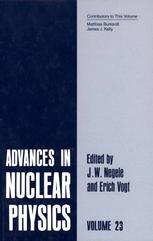

Most ebook files are in PDF format, so you can easily read them using various software such as Foxit Reader or directly on the Google Chrome browser.
Some ebook files are released by publishers in other formats such as .awz, .mobi, .epub, .fb2, etc. You may need to install specific software to read these formats on mobile/PC, such as Calibre.
Please read the tutorial at this link: https://ebookbell.com/faq
We offer FREE conversion to the popular formats you request; however, this may take some time. Therefore, right after payment, please email us, and we will try to provide the service as quickly as possible.
For some exceptional file formats or broken links (if any), please refrain from opening any disputes. Instead, email us first, and we will try to assist within a maximum of 6 hours.
EbookBell Team

4.3
38 reviewsThis volume of Advances in Nuclear Physics addresses two very different frontiers of contemporary nuclear physics — one highly theoretical and the other solidly phenomenological. The first article by Matthias Burkardt provides a pedagogical overview of the timely topic of light front quantization. Although introduced decades ago by Dirac, light front quantization has been a central focus in theoretical - clear and particle physics in recent years for two majorreasons. The first, as discussed in detail by Burkardt, is that light-cone coordinates are the natural coordinates for describing high-energy scattering. The wealth of data in recent years on nucleon and nucleus structure functions from high-energy lepton and hadron scattering thus provides a strong impetus for understanding QCD on the light cone. Second, as theorists have explored light front quantization, a host of deep and intriguing theoretical questions have arisen associated with the triviality of the vacuum, the role of zero modes, rotational invariance, and renormalization. These issues are so compelling that they are now intensively investigated on their own merit, independent of the particular application to high-energy scattering. This article provides an excellent introduction and overview of the motivation from high-energy scattering, an accessible - scription of the basic ideas, an insightful discussion of the open problems, and a helpful guide to the specialized literature. It is an ideal opportunity for those with a spectator’s acquaintance to develop a deeper understanding of this important field.